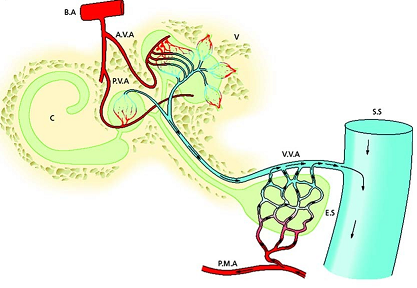 Minúsculo canal intraóseo que se origina alrededor del vestíbulo de la cápsula ótica, muy cercano a la apertura interna del acueducto vestibular, circula paralelo al acueducto vestibular, anterolateral al mismo, por la porción petrosa del hueso temporal y termina desembocando en la fosa craneal posterior junto al seno sigmoide en el que desembocan la venas que lo recorren. La más importante es la vena del acueducto del vestíbulo.
Minúsculo canal intraóseo que se origina alrededor del vestíbulo de la cápsula ótica, muy cercano a la apertura interna del acueducto vestibular, circula paralelo al acueducto vestibular, anterolateral al mismo, por la porción petrosa del hueso temporal y termina desembocando en la fosa craneal posterior junto al seno sigmoide en el que desembocan la venas que lo recorren. La más importante es la vena del acueducto del vestíbulo. <(A.): Paravestibularkanal: winziger intraossärer Kanal, der um das Vestibulum der Ohrkapsel herum ganz in der Nähe der inneren Öffnung des vestibulären Aquädukts entspringt, parallel zum vestibulären Aquädukt, anterolateral davon, durch den Felsenbeinanteil des Schläfenbeins verläuft und schließlich in die hintere Schädelgrube neben dem Sinus sigmoideus mündet, in den die ihn durchziehenden Venen münden. Die wichtigste von ihnen ist die Ader des Vestibulums.
<(F.): Canal paravestibulaire: minuscule canal intra-osseux qui prend naissance autour du vestibule de la capsule otique, très près de l'orifice interne de l'aqueduc vestibulaire, se dirige parallèlement à l'aqueduc vestibulaire, antérolatéralement à celui-ci, à travers la partie pétreuse de l'os temporal et finit par se jeter dans la fosse crânienne postérieure à côté du sinus sigmoïde dans lequel se jettent les veines qui le traversent. Le plus important d'entre eux est la veine de l'aqueduc du vestibule.
<(F.): Canal paravestibulaire: minuscule canal intra-osseux qui prend naissance autour du vestibule de la capsule otique, très près de l'orifice interne de l'aqueduc vestibulaire, se dirige parallèlement à l'aqueduc vestibulaire, antérolatéralement à celui-ci, à travers la partie pétreuse de l'os temporal et finit par se jeter dans la fosse crânienne postérieure à côté du sinus sigmoïde dans lequel se jettent les veines qui le traversent. Le plus important d'entre eux est la veine de l'aqueduc du vestibule.
<(In): Paravestibular canal: tiny intraosseous canal that originates around the vestibule of the otic capsule, very close to the internal opening of the vestibular aqueduct, runs parallel to the vestibular aqueduct, anterolateral to it, through the petrous portion of the temporal bone and ends up flowing into the posterior cranial fossa next to the sigmoid sinus into which the veins that run through it flow. The most important is the vein of the aqueduct of the vestibule.
TÉRMINOS RELACIONADOS:
